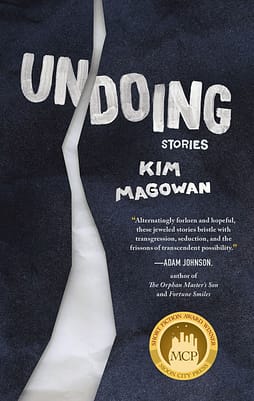
Kim Magowan’s debut collection, Undoing, published by Moon City Press, captures the vibrant, beating hearts of characters doing their best (and sometimes worst) to navigate relationships and make their way in an unpredictable world. Adept at both flash fiction and longer pieces, Magowan creates fiction that is thoughtful, exciting, and thoroughly alive.
Magowan’s story “The Rascally Rabbit” was published by Cease, Cows earlier this year. Read it here. For more, pick up a copy of Undoing—available here.
Magowan recently shared her thoughts with Cease, Cows.
Chuck Augello: Why did you choose Undoing as the title?
Kim Magowan: “Undoing” was the original title of the first story in my collection, “When in Rome,” and refers to two uses of that verb that appear in the final paragraph: the narrator undoing a bad memory of sex through conjuring a replacement fantasy, and, within the fantasy, undoing the buttons of the shirt of the man she desires. I like the title because it encapsulates opposite concepts: undoing as a synonym for destruction (“Cocaine was my undoing”), and undoing as a concept for repair (undoing a knot, undoing a crisis). Both of those trajectories—falling apart, but also, wanting desperately to reassemble things—are important to my story collection. It’s a one-word title that carries a lot of load: it’s a weight-bearing beam.
CA: The collection features a mix of flash fiction and longer pieces. When beginning a new story, do you have a length in mind, or does the story let you know during its writing?
KM: Sometimes I know from the get-go a story will be short, because the concept requires brevity, like “Subject: Lay Off the Lays.” I want that story to sound like an email that someone would plausibly bang out. Sometimes, as you put it, the story “lets me know.” A lot of my stories, like recalcitrant toddlers, have minds of their own. I thought “Version” would be pithy; it kept growing hydra heads. I thought “Daisy Chain” would be a long story about grief and reckoning; at about 800 words, it put its hands on its hips, and told me it had said what it wanted to say. My revision process mostly involves chiseling, so my final drafts are always trimmer and more muscular than they start off being. They sweat out all the water.
CA: Many of our readers also write flash fiction. What do you think makes a flash story successful? Any tips for writers new to flash?
KM: A good flash story can’t feel slight or rushed. I write first drafts of my flash stories in a sitting (my process is I need to slap down all the components raw, unfiltered), but I labor over flash in revision. They can’t have waste; every word earns its place. For new writers of flash, I recommend David Galef’s Brevity: A Flash Fiction Handbook. It’s a great how-to book on the main modes of flash (like the vignette, the list, the slice of life, the character sketch). I’m an English professor; I believe that the best way to learn how to write well is to read experts. Lydia Davis, Kathy Fish, Amy Hempel, Jamaica Kincaid, Sherrie Flick, Kim Chinquee, Michelle Ross, and Rebecca Schiff all write superb flash. George Saunders’s “Sticks” is a masterpiece. My advice about flash is to respect the form. A friend told me recently she doesn’t think flash stories are real stories; I completely disagree. Compression is difficult; compression requires skill. Learning to write flash well means you will be a better writer of novels. Every writer should try flash. It’s the most disciplined form of prose.
CA: We enjoy learning how stories make their way into the world, from the writer’s mind to the reader’s eye. Can you tell us about one of the stories in Undoing, from the moment of initial inspiration to its final acceptance?
KM: One of my favorite stories is “This Much,” the closer of my collection. It’s a love story, about a relationship that is ending. Indeed, it has ended, though in a private way (the spouses are keeping up the façade to get through their daughter’s wedding, drama-free). Miriam and Ben still love each other: that is central. I always see these Facebook status reports or announcements of some celebrity couple splitting up, that maintain the two people separating are good friends who still love each other. That’s a frosting cupcake announcement—it’s PR—but I wanted to explore how breaking up can, counter-intuitively, free people to express love. When you no longer expect someone who has repeatedly disappointed you to come through, finally you cut them slack. It’s an opportunity to be authentic. Of course, that’s an opportunity that is hard to risk, since the process of separating involves defending against loss by coating oneself in armor. In both my novel and my story collection, the romantic partners who feel most deeply for each other are in stages of estrangement (Miriam and Ben in “This Much,” the narrator and his ex-wife Constance in “Tabloid,” Mel and Phil in “Family Games”). It’s a state I find fascinating: what happens, after the end?
So, “This Much” is a story I care a lot about, and it took FOREVER to publish. I got more rejections for that one that any other single story, more than 50. Many of those rejections were positive, but it was demoralizing. This was back when I only had three or four stories published. So peddling “This Much” was my first real lesson in persistence— I needed to have faith that my story was good, despite all evidence to the contrary. The journal that finally accepted it, Arroyo Literary Review, nominated it for a Pushcart Prize. When I went to their launch party to read the story, I told the managing editor, “You have good taste.” Which is such an obnoxious thing to say, so not my usual insecure style! The vagaries of publishing confuse me. Stories I feel much less sure about get snapped up immediately. I’m proud of “This Much,” and I’m proud of myself for not giving up on it. That couple were meaningful enough to me that I wrote another story about them, “Brining,” because I wanted to give Ben and Miriam a happier ending, even if I knew (the logic of hindsight) it couldn’t stay happy.
CA: Several stories, like “Buko” and “When in Rome,” find the narrator addressing a “You” character. How does this form of direct address influence the telling of the story?
KM: It’s common for poems to address a “you,” but unusual for fiction. Both of those protagonists are addressing “you” in their imagination—these are the conversations you rehearse in the shower. Both of them are “talking” to people they can’t talk freely to in real life (the real life of fictional construct). Emily addresses someone she feels wistful towards, though she’s also chagrined. The narrator in “Buko” addresses a partner who feels so threatened she’s applied for a restraining order: communication has broken down. I’ve never thought of those stories as a pair, but your question shows me that they are linked—not simply because they address offstage auditors, but also because both narrators think the solution to their present states of impasse lies in an act of imaginative rewriting. Emily in “When in Rome” is more cerebral about the fantasy she conjures, but the narrator in “Buko” is involved in a similar mode of magical thinking: he tries to resurrect a past when his estranged partner followed direction, accepted his expertise. I like that “you” form of address because it’s intimate. The reader is put in a voyeuristic role, overhearing something very private, probably not even articulated out loud.
CA: Putting together a collection involves a lot more than simply saving all your stories together in one document. Tell us about the making of the book. What factors did you consider when choosing which stories to include and the particular order in which they would appear?
KM: Composing a story collection is so much more arduous and labor-intensive than writing a novel. It annoys me that literary agents and prestigious awards (like the Man Booker) see story collections as a lesser genre. Of course it’s easier to write a story than a novel, but it’s so much easier to write a 225 page novel than a 225 page story collection. Once I hit a certain word count (around 50,000), I stopped adding to the collection a story at a time, and began curating: identifying which stories were not up to par, and which stories I liked but seemed redundant, and giving them the hook (like an old-time Vaudeville stage manager, wielding the cane). I put a ridiculous amount of time and thought into sequence. I wanted an opening story that set the stage for what the collection was “about”; I wanted a closing story that would linger; I wanted a tent-pole to hold up armature. But also, I needed variety—in POV, tone, length. I didn’t want stories in a row that hit the same note. There are twenty-nine stories, so it was a lot of concepts to consider; I was juggling kumquats. I put dozens of hours, and consulted my good friend, the writer Michelle Ross, about sequence. Inevitably, coming back from this year’s AWP, I sat next to someone on the plane who told me that she NEVER reads short story collections in order. Aghast, I asked her, “Well, how do you choose what to read”? She goes by which title intrigues her, or story length. So there go the best laid plans of mice and men….
CA: Though only four pages, “Squirrel Beach” offers some complex family dynamics. At first, we think the story is about the narrator’s sister-in-law and her drinking problem, but there is a lot more going on. Tell us about it.
KM: “Squirrel Beach” is one of the stories I am proudest of. It’s also, for me, an example of how flash can (and should) be as rich and dimensional as a longer story. So yes, that story is about a lot of things. The narrator Liz also has a drinking problem, one that she isn’t willing to tackle. Liz feels abandoned by her now sober sister-in-law Katrine, not just because Katrine was her drinking buddy, but also because Katrine was her way of escaping, with a companion, from her family. Since Katrine offers her a respite, Liz is radically disloyal to her brother Seth, Katrine’s husband. Katrine confides in her about cheating on Seth, and Liz treats the developing affair like a telenovela; she never discourages Katrine. So yes, that story is a baklava: there are a lot of layers, more than what I’ve described. One example: the editor who accepted it wanted to know if it was a mistake that Liz’s daughter has the same first name as her former friend Claire. Nope, that’s intentional. As I told the editor, it’s a connection that matters, but that my narrator would never be equipped (or willing) to reflect about. Good flash should lay out all the dots for the reader to connect; I have faith in readers being astute. I’m glad you like that story! It’s the one I read at AWP.
CA: This question comes straight from your story “Nepenthes.” If you were a verb, which one would you be?
KM: Dither.
CA: Do you have a favorite piece of short fiction? If you could save only one story from extinction, which would you choose?
KM: Cruel question! Okay, I’m going with Alice Munro’s “The Bear Came Over the Mountain,” but ouch! All around me, I can hear the screams of dying stories I adore.
CA: Finally, there is no shortage of ways to spend one’s time. Why do you choose to write fiction?
KM: I would be a maniac if I didn’t write! Seriously, I wouldn’t be fit for human company. The most compact answer to that question is, I have things to say, and I express them best through writing.
–
Chuck Augello (Contributing Editor) lives in New Jersey with his wife, dog, two cats, and several cows that refuse to cease. His work has appeared in One Story, Juked, Hobart, SmokeLong Quarterly, and other fine places. He publishes The Daily Vonnegut and contributes interviews to The Review Review. He’s currently at work on a novel.

